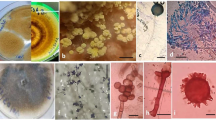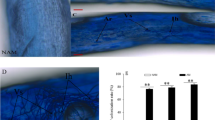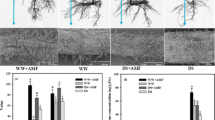Summary
Secondary side branching in Salvinia molesta plants grown in nutrient solution was dependent on the availability of nitrogen. The compensatory response of S. molesta to damage by complete manual disbudding was the production of extensive secondary side branching at nitrogen levels below those required for this type of branching in undamaged plants. After 28 days damaged plants had the same number of ramets as undamaged plants but the dry weight was considerably reduced.
After 7 days there was no change in dry weight with partial or complete disbudding. However completely disbudded plants had no new ramets and plants with all terminal buds removed had numbers of ramets significantly reduced. The concentration of nitrogen in the tissue of new growth was higher in damaged than undamaged plants. The results are discussed in relation to the biological control of S. molesta by the bud-eating weevil, Cyrtobagous salviniae.
Similar content being viewed by others
References
Bell AD, Tomlinson PB (1980) Adaptive architecture in rhizomatous plants. Bot J Linn Soc 80:125–160
Cary PC, Weerts PGJ (1983a) Growth of Salvinia molesta as affected by water temperature and nutrition. I. Effects of nitrogen level and nitrogen compounds. Aquat Bot 16:163–172
Cary PC, Weerts PGJ (1983b) Growth of Salvinia molesta as affected by water temperature and nutrition. II. Effects of phosphorous level. Aquat Bot 17:61–70
Cary PC, Weerts PGJ (1984) Growth of Salvinia molesta as affected by water temperature and nutrition. III. Nitrogen-phosphorous interaction and effects of pH. Aquat Bot 19:171–182
Ericsson A, Hellquist C, Långström B, Larsson S, Tenow O (1985) Effects on growth of simulated and induced shoot pruning by Tomicus piniperda as related to carbohydrate and nitrogen dynamics in Scots pine. J Appl Ecol 22:105–124
Forno IW, Harley KLS (1979) The occurrence of Salvinia molesta in Brazil. Aquat Bot 6:185–187
Forno IW, Sands DPA, Sexton W (1983) Distrubition, biology and host specificity of Cyrtobagous singularis Hustache (Coleoptera: Curculionidae) for the biological control of Salvinia molesta. Bull ent Res 73:85–95
Gaudet JJ (1973) Growth of a floating aquatic weed Salvinia under standard conditions. Hydrobiologia 41:77–106
Harper JL (1977) Population biology of plants. Academic Press, London, p 892
Hewitt EJ (1966) Sand and water culture methods used in the study of plant nutrition. Tech. Comm. 2, revised 2nd ed, Commonwealth Agricultural Bureaux, England, p 547
Holm LG, Plunckett DL, Pancho JV, Herberger JP (1977) The world's worst weeds. Distribution and biology. The University Press of Hawaii, Honolulu, p 609
Islam Z, Crawley MJ (1983) Compensation and regrowth in ragwort (Senecio jacobaea) attacked by cinnibar moth (Tyria jacobaeae). J Ecol 71:829–843
Mitchell DS (1978) Aquatic weeds in Australian inland waters. Australian Government Publishing Service, Canberra, p 189
Mitchell DS, Rose DJW (1979) Factors affecting fluctuations in extent of Salvinia molesta on Lake Kariba PANS. Pest Artic News Summ 25:171–177
Mitchell DS, Tur NM (1975) The rate of growth of Salvinia molesta (S. auriculata Auct.) in laboratory and natural conditions. J Appl Ecol 12:213–225
Rao YRM, Narayana R (1968) Effects of mineral nutrition and auxins on Salvinia auriculata Aublet, grown in cultures. J Mysore Univ Sedt B:136–143
Room PM (1983) ‘Falling apart’ as a life style: the rhizome architecture and population growth of Salvinia molesta. J Ecol 71:349–365
Room PM, Forno IW, Taylor MFJ (1984) Establishment in Australia of two insects for biological control of the floating weed Salvinia molesta Mitchell. Bull ent Res 74:505–516
Room PM, Harley KLS, Forno IW, Sands DPA (1981) Successful biological control of the floating weed salvinia. Nature (London) 294:78–80
Room PM, Thomas PA (1985) Nitrogen and establishment of a beetle for biological control of the floating weed Salvinia in Papua New Guinea. J Appl Ecol 22:139–156
Sands DPA, Schotz M, Bourne AS (1983) The feeding characteristics and development of larvae of a salvinia weevil Cyrtobagous sp. Ent exp & appl 34:291–296
Snedecor GW, Cochran WG (1980) Statistical methods. The Iowa State University Press, Ames, p 593
Solomon BP (1983) Compensatory production in Solanum carolinense following attack by a host-specific herbivore. J Ecol 71:681–690
Thomas PA (1985) Management of Salvinia molesta in Papua New Guinea. FAO Plant Prot Bull 33:50–56
Thomas PA, Room PM (1986) Toward biological control of Salvinia molesta in Papua New Guinea. Proc 6th Int Symp Biol Contr Weeds, Vancouver, 1984 (in press)
Author information
Authors and Affiliations
Rights and permissions
About this article
Cite this article
Julien, M.H., Bourne, A.S. Compensatory branching and changes in nitrogen content in the aquatic weed Salvinia molesta in response to disbudding. Oecologia 70, 250–257 (1986). https://doi.org/10.1007/BF00379248
Received:
Issue Date:
DOI: https://doi.org/10.1007/BF00379248




